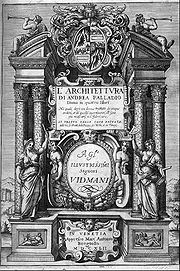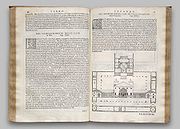
I Quattro Libri dell'Architettura
Encyclopedia

Architecture
Architecture is both the process and product of planning, designing and construction. Architectural works, in the material form of buildings, are often perceived as cultural and political symbols and as works of art...
by the architect Andrea Palladio
Andrea Palladio
Andrea Palladio was an architect active in the Republic of Venice. Palladio, influenced by Roman and Greek architecture, primarily by Vitruvius, is widely considered the most influential individual in the history of Western architecture...
(1508-1580). It was first published in four volume
Volume
Volume is the quantity of three-dimensional space enclosed by some closed boundary, for example, the space that a substance or shape occupies or contains....
s in 1570 in Venice
Venice
Venice is a city in northern Italy which is renowned for the beauty of its setting, its architecture and its artworks. It is the capital of the Veneto region...
, illustrated with woodcuts after the author's own drawings. It has been reprinted and translated many times (often in single-volume format). Book I was first published in English in 1663 in a London edition by Godfrey Richards. The first complete English language edition was published in London by the Italian-born architect Giacomo Leoni
Giacomo Leoni
Giacomo Leoni , also known as James Leoni, was an Italian architect, born in Venice. He was a devotee of the work of Florentine Renaissance architect Leon Battista Alberti, who had also been an inspiration for Andrea Palladio. Leoni thus served as a prominent exponent of Palladianism in English...
in 1716-1720.
Palladio founded an architectural movement which takes its name from him, Palladian architecture
Palladian architecture
Palladian architecture is a European style of architecture derived from the designs of the Venetian architect Andrea Palladio . The term "Palladian" normally refers to buildings in a style inspired by Palladio's own work; that which is recognised as Palladian architecture today is an evolution of...
. I quattro libri dell'architettura contains Palladio's own designs celebrating the purity and simplicity of classical architecture
Classical architecture
Classical architecture is a mode of architecture employing vocabulary derived in part from the Greek and Roman architecture of classical antiquity, enriched by classicizing architectural practice in Europe since the Renaissance...
. Some of these ideas had not got further than the drawing board while others, for example villa
Villa
A villa was originally an ancient Roman upper-class country house. Since its origins in the Roman villa, the idea and function of a villa have evolved considerably. After the fall of the Roman Republic, villas became small farming compounds, which were increasingly fortified in Late Antiquity,...
plans, had been successfully built. The book's clarity inspired numerous patron
Patrón
Patrón is a luxury brand of tequila produced in Mexico and sold in hand-blown, individually numbered bottles.Made entirely from Blue Agave "piñas" , Patrón comes in five varieties: Silver, Añejo, Reposado, Gran Patrón Platinum and Gran Patrón Burdeos. Patrón also sells a tequila-coffee blend known...
s and other architects. Palladian architecture grew in popularity across Europe
Europe
Europe is, by convention, one of the world's seven continents. Comprising the westernmost peninsula of Eurasia, Europe is generally 'divided' from Asia to its east by the watershed divides of the Ural and Caucasus Mountains, the Ural River, the Caspian and Black Seas, and the waterways connecting...
and, by the end of the 18th century, had extended as far as North America
North America
North America is a continent wholly within the Northern Hemisphere and almost wholly within the Western Hemisphere. It is also considered a northern subcontinent of the Americas...
. Thomas Jefferson
Thomas Jefferson
Thomas Jefferson was the principal author of the United States Declaration of Independence and the Statute of Virginia for Religious Freedom , the third President of the United States and founder of the University of Virginia...
, president
President
A president is a leader of an organization, company, trade union, university, or country.Etymologically, a president is one who presides, who sits in leadership...
of the United States
United States
The United States of America is a federal constitutional republic comprising fifty states and a federal district...
, was a keen admirer of Palladio and once referred to the book as "the Bible". The Four Books was used to inform his own work as the architect of Monticello
Monticello
Monticello is a National Historic Landmark just outside Charlottesville, Virginia, United States. It was the estate of Thomas Jefferson, the principal author of the United States Declaration of Independence, third President of the United States, and founder of the University of Virginia; it is...
and the University of Virginia
University of Virginia
The University of Virginia is a public research university located in Charlottesville, Virginia, United States, founded by Thomas Jefferson...
and also architect William Buckland's at the 1774 Hammond-Harwood House in Annapolis, Maryland.
Palladio drew inspiration from surviving Roman buildings, Roman authors (especially the architect Vitruvius
Vitruvius
Marcus Vitruvius Pollio was a Roman writer, architect and engineer, active in the 1st century BC. He is best known as the author of the multi-volume work De Architectura ....
) and Italian Renaissance architects. However, The Four Books of Architecture provided systematic
Systematic
Systematic is an American hard rock band from Oakland, California. They were one of the first signings to Metallica drummer Lars Ulrich's record label, The Music Company, via Elektra Records. The band released two studio albums before disbanding in 2004....
rules and plans for buildings which were creative and unique. Palladio’s villa style is based on details applied to a structural system built of bricks. He offers two types of general rules in the corpus: design rules (those based on appearance) and construction rules (those based on the logic of villa construction). Here rules of the two types are identified in sets from which sub-sets of identifiers and rules can be written.
Each of the nine rule-sets contains many sub-identities of components and procedures for physical construction. A rule-set such as “Walls”, that identifies five sub-rules based on wall thickness, only needs construction rules; there is no need for rules based on style. In contrast, rules for “Frames” are based on a geometric style of curves and shape proportions. The results will yield clear identities for a shape grammar
Grammar
In linguistics, grammar is the set of structural rules that govern the composition of clauses, phrases, and words in any given natural language. The term refers also to the study of such rules, and this field includes morphology, syntax, and phonology, often complemented by phonetics, semantics,...
composition
Composition (visual arts)
In the visual arts – in particular painting, graphic design, photography and sculpture – composition is the placement or arrangement of visual elements or ingredients in a work of art or a photograph, as distinct from the subject of a work...
that can be based on physical construction and visual style.
These identities are taken from the first book of architecture and a survey of built villas. These are the nine rule-sets that define identity:

- Walls — parametricParametricParametric may refer to:*Parametric equation*Parametric statistics*Parametric derivative*Parametric plot*Parametric model*Parametric oscillator *Parametric contract*Parametric insurance*Parametric feature based modeler...
formulaFormulaIn mathematics, a formula is an entity constructed using the symbols and formation rules of a given logical language.... - Ceilings — parametric formula
- Stairs — parametric formula
- Columns — parametric object
- Doors — parametric formula
- Windows — parametric formula
- Frames — parametric object
- Roof — parametric formula
- Details — parametric object and formula
See also
- Andrea PalladioAndrea PalladioAndrea Palladio was an architect active in the Republic of Venice. Palladio, influenced by Roman and Greek architecture, primarily by Vitruvius, is widely considered the most influential individual in the history of Western architecture...
- Palladian Villas of the VenetoPalladian Villas of the VenetoThe City of Vicenza and the Palladian Villas of the Veneto is a World Heritage Site protecting a cluster of works by the architect Andrea Palladio. UNESCO inscribed the site on the World Heritage List in 1994. At first the site was called "Vicenza, City of Palladio" and only buildings in the...
- Palladian architecturePalladian architecturePalladian architecture is a European style of architecture derived from the designs of the Venetian architect Andrea Palladio . The term "Palladian" normally refers to buildings in a style inspired by Palladio's own work; that which is recognised as Palladian architecture today is an evolution of...
External links
- I quattro libri dell'architettura, ne' quali, dopo un breue trattato de' cinque ordini, & di quelli auertimenti, che sono piu necessarii nel fabricare; si tratta delle case private, delle vie, de i ponti, delle piazze, de i xisti, et de' tempij. — downloadable pdf first edition from the Library of Congress
- I Quattro Libri dell'Architettura — facsimile of the book at octavo.com

